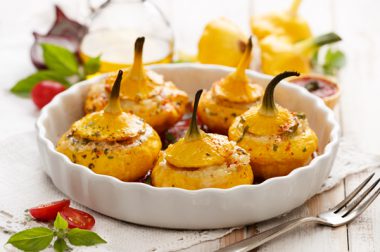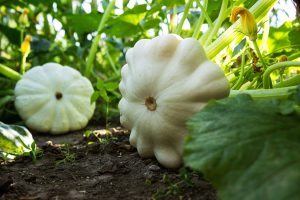Recipes we love
See all recipesIndian soup with pumkin
The Indian soup, including lentils and vegetables, can be a main course dish and is a well balanced ...
Fried pumpkin
A nice way to discover a not so well-known vegetable. A dish with pro-vitamin A; a vitamin that help...
Health
benefits
A summer squash
With a high water content like all other vegetables in the gourd family, pattypan squash is distinguished from winter squash by its season: summer!
Pattypan squash is also :
- a source of potassium (for the nervous system, muscular function, and blood pressure)
It also contains:
- vitamin C (multifunctional vitamin: nervous system, skin, energy metabolism, immunity, etc.)
- vitamin B9 or folic acid (for cellular renewal, particularly important for pregnant women for fetal development, for children who are growing, and people who are convalescing)
- manganese (energy metabolism, healthy bones, antioxidant)
- antioxidants (lutein and zeaxanthin)
Nutritional
composition
When is the right
time to eat it?
Summer.
Unlike winter squash and red kuri squash, but similar to zucchini, pattypan is a summer squash (in season from July to September).
Vegetable patch
or urban balcony?
Pattypan squash is an annual that grows well in full sun, in rich, deep soil rich in humus.
To learn everything you need to know about growing pattypan squash, read the page on growing advice.
Choosing and
storing pattypan squash
Choose your pattypan squash well :
- Pattypan squash should be smooth and very firm, and the skin should not have spots.
- Smaller pattypan squashes are better than bigger ones, as their flesh is tenderer.
- Larger pattypan squashes are great for making stuffed squash.
Properly store your pattypan squash :
- In the refrigerator: Store for two to three days in the vegetable drawer, as it will last less long than squashes that are in season in winter (winter squash, red kuri squash, butternut squash, etc.).
- In the freezer: blanch pattypan squash before freezing.
Anti-waste tips
Don’t throw away the peel, as it’s edible! There are many ways to cook it: stuffed in the oven, in a quiche or a soup, sauté in a frying pan and more!
And don’t throw away the seeds either! You can grill them on the hob or in the oven with some salt and spices, to make a delicious treat in a salad or as nibbles.
Have you already heard about the 0 waste challenge? Find out more…
What is the evironmental impact?
The Product Environmental Footprint (PEF), a score established by Agribalyse*, tells us more! It takes account of all the phases in a vegetable’s life cycle: how it’s grown, the impact of its transport, the impact of its processing, and so on. The lower the score, the lower the environmental impact. It does not have precise data on a pattypan squash, but the data on other squashes gives us an indication:
- Squash, raw: 0.10
- Pumpkin, raw: 0.10
- Pumpkin, cooked: 0.19
- Steak, raw: 2.77
*Data taken from the Agribalyse database, which gives the environmental score of foodstuffs. This unique score is the average of 16 indicators, calculated using the European methodology PEF. It is not the same as an environmental label or “eco-score”.
CO2 equivalent: for 100g of raw squash: 0.055 kg of CO2 eq, which is the same as 1.6 g of raw steak or driving 220 m by car
Do you want to take action for more sustainable food systems? Here’s how.
Tips and
tricks
How to prepare pattypan squash
No need to peel this squash! Cook it with its skin on, like most squashes.
Pattypan squash can be cooked whole, then stuffed with its own insides mixed with fresh cheese or ground meat, herbs, and shallots. It can also be thinly sliced or cut into cubes.
Cooking times:
- 30 minutes: in boiling water
- 15 minutes: in a pressure cooker
- 40 minutes: in the oven
The pattypan squash does not need too much preparation, making it an ideal vegetable for those who don’t want to spend much time in the kitchen! Cut the squash in two, add some oil, spices and herbs and put in a preheated oven to roast! Read HERE how to cook vegetables easily!
Pattypan squash goes well with…
Raw: Young pattypan squash can be eaten raw, cut into thin strips and added to a salad.
Cooked: It can be eaten au gratin, with béchamel sauce and grated cheese. As with most squashes, you can use pattypan squash to make tarts and savory cakes, or you can eat it with quiche, risotto, cheese, mussels, and more.
Can everyone
eat it?

Young children
Starting at age 6 months, children can eat pattypan squash in soup or puree form, or stewed in a sweet sauce.
And everyone else
Everyone likes pattypan squash for its sweet flavor, similar to that of artichokes, and its melt-in-the-mouth texture.
See plenty of other tips for encouraging children to eat vegetables
Where does it come from?
Origins and varieties
Origins
The French name for the pattypan squash, pâtisson, comes from a cake baked in a scallop-edged mold. Like other members of the Cucurbitaceae family, pattypan squash is native to Central America.
Varieties
Pattypan squash belongs to the Cucurbitaceae family. However, contrary to appearances, it does not belong to the same variety as winter squash but to that of zucchini (Cucurbita pepo L.). It can be white, yellow, orange, or green, or even both white and green or green and yellow, and it varies in size and weight from a miniature version (around 10 inches in diameter) to a giant version (weighing up to around 5.5 pounds).
Pattypan squash is one of the ancient, oft-forgotten vegetables that fortunately is making a comeback in market stalls and garden plots.



 Artichoke
Artichoke  Fava beans
Fava beans  Vegetable garden: growing gherkin
Vegetable garden: growing gherkin 










